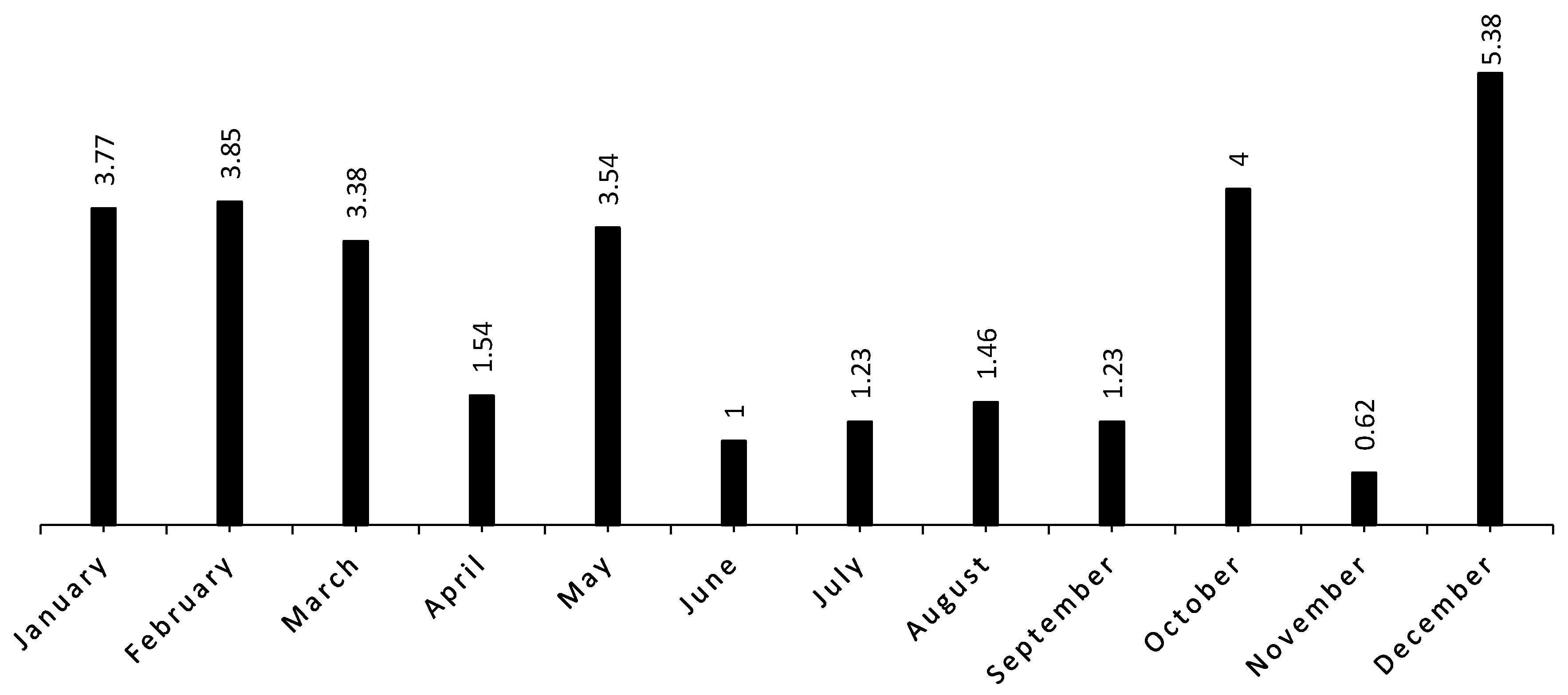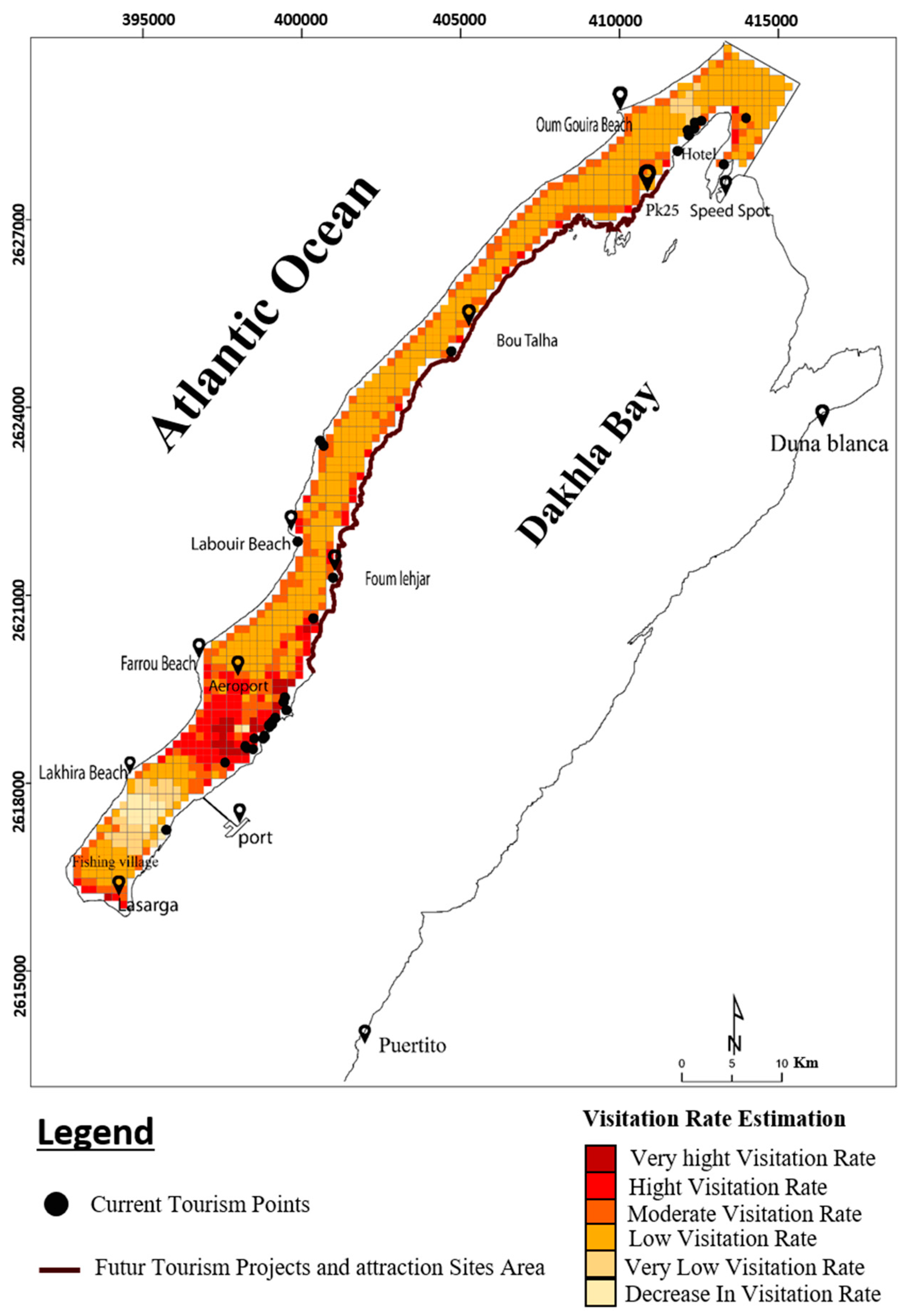A New Approach to Mapping Cultural Ecosystem Services
Abstract
:1. Introduction
2. Materials and Methods
2.1. Study Area
2.2. Tourism and Recreation Model
2.2.1. Data Used and Criteria
- ♦
- Natural landscapes, nature, water bodies, and hydrology are among the most used variables in CES for recreational choice models.
- ▪
- Beaches: All Dakhla Bay beaches already included in the study area map (PK 25 Beach, Boutelha Beach, Farrou Beach, Lakhira Beach, Labouir Beach, Oum Gouira Beach, Foum Lahjar Beach, speed spot, and fishing villages).
- ▪
- Natural areas: White dune, orchards, meadows, and forests.
- ♦
- Potential of landscape features: The potential of the landscape variables were included in the model to consider the infrastructures and the potential demands related to the CES.
- ▪
- Attractions sites: Hotels, restaurants, ports, host houses, Lasarga, oyster farms, surf schools, and kitesurf schools.
- ▪
- Campsites.
- ▪
- Roads.
- ▪
- Aerodrome.
- ▪
- Parks and semi-natural areas (green urban areas).
- ♦
- Forecast data: The future projects collected in situ from the Tourism Delegation of Dakhla City.
2.2.2. InVEST Recreation Model
2.3. Model Limitations
2.4. GIS Statistical Analysis
3. Results
3.1. Average Annual Visit Rate Mapping
3.2. Monthly Visit Rate Mapping
3.3. Annual Visit Rate Estimation
4. Discussion
4.1. InVEST Results and Dakhla Tourism Surveys
4.2. Analysis of Landscape Attributes
4.3. Decision-Making and Management Implications
5. Conclusions
Author Contributions
Funding
Institutional Review Board Statement
Informed Consent Statement
Acknowledgments
Conflicts of Interest
References
- Costanza, R.; d’Arge, R.; de Groot, R.; Farber, S.; Grasso, M.; Hannon, B.; Limburg, K.; Naeem, S.; O’Neill, R.V.; Paruelo, J.; et al. The value of the world’s ecosystem services and natural capital. Nature 1997, 387, 253–260. [Google Scholar] [CrossRef]
- Fish, R.; Church, A.; Winter, M. Conceptualising cultural ecosystem services: A novel framework for research and critical engagement. Ecosyst. Serv. 2016, 21, 208–217. [Google Scholar] [CrossRef] [Green Version]
- Mace, G.; Masundire, H.; Baillie, J. Biodiversity. In Ecosystems and Human Wellbeing: Current State and Trends; Island Press: Washington, DC, USA, 2005; Volume 1, pp. 77–122. [Google Scholar]
- Chan, K.M.A.; Guerry, A.D.; Balvanera, P.; Klain, S.; Satterfield, T.; Basurto, X.; Bostrom, A.; Chuenpagdee, R.; Gould, R.K.; Halpern, B.S.; et al. Where are Cultural and Social in Ecosystem Services? A Framework for Constructive Engagement. BioScience 2012, 62, 744–756. [Google Scholar] [CrossRef]
- Goodchild, M.F. Citizens as sensors: The world of volunteered geography. Geojournal 2007, 69, 211–221. [Google Scholar] [CrossRef] [Green Version]
- Maes, J.; Brat, L.; Jax, K.; Hutchins, M.; Furman, E.; Termansen, M.; Luque, S.; Williams, M.L.P.C.C.R.; Volk, M.; Lautenbach, S.; et al. A Spatial Assessment of Ecosystem Services in Europe: Methods, Case Studies and Policy Analysis—Phase 1; PEER Report No. 3; Partnership for European Environmental Research: Copenhagen, Denmark, 2011. [Google Scholar]
- Santarém, F.; Saarinen, J.; Brito, J.C. Assessment and prioritization of cultural ecosystem services in the Sahara-Sahelian region. Sci. Total Environ. 2021, 777, 146053. [Google Scholar] [CrossRef]
- Lee, J.-H.; Park, H.-J.; Kim, I.; Kwon, H.-S. Analysis of cultural ecosystem services using text mining of residents’ opinions. Ecol. Indic. 2020, 115, 106368. [Google Scholar] [CrossRef]
- Milcu, A.I.; Hanspach, J.; Abson, D.; Fischer, J. Cultural Ecosystem Services: A Literature Review and Prospects for Future Research. Ecol. Soc. 2013, 18. [Google Scholar] [CrossRef] [Green Version]
- Guo, Z.; Zhang, L.; Li, Y. Increased Dependence of Humans on Ecosystem Services and Biodiversity. PLoS ONE 2010, 5, e13113. [Google Scholar] [CrossRef]
- Tenerelli, P.; Demšar, U.; Luque, S. Crowdsourcing indicators for cultural ecosystem services: A geographically weighted approach for mountain landscapes. Ecol. Indic. 2016, 64, 237–248. [Google Scholar] [CrossRef] [Green Version]
- Liquete, C.; Piroddi, C.; Macías, D.; Druon, J.-N.; Zulian, G. Ecosystem services sustainability in the Mediterranean Sea: Assessment of status and trends using multiple modelling approaches. Sci. Rep. 2016, 6, 34162. [Google Scholar] [CrossRef] [Green Version]
- Langemeyer, J.; Calcagni, F.; Baró, F. Mapping the intangible: Using geolocated social media data to examine landscape aesthetics. Land Use Policy 2018, 77, 542–552. [Google Scholar] [CrossRef]
- Clemente, P.; Calvache, M.; Antunes, P.; Santos, R.; Cerdeira, J.O.; Martins, M.J. Combining social media photographs and species distribution models to map cultural ecosystem services: The case of a Natural Park in Portugal. Ecol. Indic. 2019, 96, 59–68. [Google Scholar] [CrossRef]
- Klain, S.C.; Satterfield, T.A.; Chan, K.M.A. What matters and why? Ecosystem services and their bundled qualities. Ecol. Econ. 2014, 107, 310–320. [Google Scholar] [CrossRef]
- Iniesta-Arandia, I.; García-Llorente, M.; Aguilera, P.A.; Montes, C.; Martín-López, B. Socio-cultural valuation of ecosystem services: Uncovering the links between values, drivers of change, and human well-being. Ecol. Econ. 2014, 108, 36–48. [Google Scholar] [CrossRef]
- Oteros-Rozas, E.; Martin-Lopez, B.; González, J.A.; Plieninger, T.; López, C.A.; Montes, C. Socio-cultural valuation of ecosystem services in a transhumance social-ecological network. Reg. Environ. Chang. 2013, 14, 1269–1289. [Google Scholar] [CrossRef]
- Norton, L.; Inwood, H.; Crowe, A.; Baker, A. Trialling a method to quantify the ‘cultural services’ of the English landscape using Countryside Survey data. Land Use Policy 2012, 29, 449–455. [Google Scholar] [CrossRef] [Green Version]
- Martínez-Harms, M.J.; Balvanera, P. Methods for mapping ecosystem service supply: A review. Int. J. Biodivers. Sci. Ecosyst. Serv. Manag. 2012, 8, 17–25. [Google Scholar] [CrossRef]
- Burkhard, B.; Kroll, F.; Nedkov, S.; Müller, F. Mapping ecosystem service supply, demand and budgets. Ecol. Indic. 2012, 21, 17–29. [Google Scholar] [CrossRef]
- Heipke, C. Crowdsourcing geospatial data. ISPRS J. Photogramm. Remote. Sens. 2010, 65, 550–557. [Google Scholar] [CrossRef]
- Sonter, L.J.; Watson, K.B.; Wood, S.A.; Ricketts, T.H. Spatial and Temporal Dynamics and Value of Nature-Based Recreation, Estimated via Social Media. PLoS ONE 2016, 11, e0162372. [Google Scholar] [CrossRef] [Green Version]
- Hamstead, Z.A.; Fisher, D.; Ilieva, R.T.; Wood, S.A.; McPhearson, T.; Kremer, P. Geolocated social media as a rapid indicator of park visitation and equitable park access. Comput. Environ. Urban Syst. 2018, 72, 38–50. [Google Scholar] [CrossRef]
- Richards, D.R.; Tuncer, B. Using image recognition to automate assessment of cultural ecosystem services from social media photographs. Ecosyst. Serv. 2018, 31, 318–325. [Google Scholar] [CrossRef]
- Park, S.B.; Kim, J.; Lee, Y.K.; Ok, C.M. Visualizing theme park visitors’ emotions using social media analytics and geospatial analytics. Tour. Manag. 2020, 80, 104127. [Google Scholar] [CrossRef]
- Xu, X.; Li, Y. The antecedents of customer satisfaction and dissatisfaction toward various types of hotels: A text mining approach. Int. J. Hosp. Manag. 2016, 55, 57–69. [Google Scholar] [CrossRef]
- Wood, S.A.; Guerry, A.D.; Silver, J.M.; Lacayo, M. Using social media to quantify nature-based tourism and recreation. Sci. Rep. 2013, 3, 02976. [Google Scholar] [CrossRef]
- Keeler, B.L.; Wood, S.A.; Polasky, S.; Kling, C.L.; Filstrup, C.T.; Downing, J.A. Recreational demand for clean water: Evidence from geotagged photographs by visitors to lakes. Front. Ecol. Environ. 2015, 13, 76–81. [Google Scholar] [CrossRef] [Green Version]
- Cunha, J.; Elliott, M.; Ramos, S. Linking modelling and empirical data to assess recreation services provided by coastal habitats: The case of NW Portugal. Ocean Coast. Manag. 2018, 162, 60–70. [Google Scholar] [CrossRef]
- Salas-Olmedo, M.H.; Moya-Gómez, B.; García-Palomares, J.C.; Gutiérrez, J. Tourists’ digital footprint in cities: Comparing Big Data sources. Tour. Manag. 2018, 66, 13–25. [Google Scholar] [CrossRef] [Green Version]
- Purves, R.; Hollenstein, L. Exploring place through user-generated content: Using Flickr to describe city cores. J. Spat. Inf. Sci. 2010, 1, 21–48. [Google Scholar] [CrossRef]
- RAMSAR. Convention on Wetland RAMSAR; RAMSAR: Gland, Switzerland, 2005; p. 323. [Google Scholar]
- Sharp, E.R.; Tallis, H.T.; Ricketts, T.; Guerry, A.D.; Wood, S.A.; Chaplin-Kramer, R.; Nelson, E.; Ennaanay, D.; Wolny, S.; Olwero, N.; et al. InVEST Guide Natural Capital Project; The Natural Capital Project, Stanford Unviersity: Stanford, CA, USA, 2018. [Google Scholar]
- Guerry, A.D.; Ruckelshaus, M.H.; Arkema, K.K.; Bernhardt, J.R.; Guannel, G.; Kim, C.-K.; Marsik, M.; Papenfus, M.; Toft, J.E.; Verutes, G.; et al. Modeling benefits from nature: Using ecosystem services to inform coastal and marine spatial planning. Int. J. Biodivers. Sci. Ecosyst. Serv. Manag. 2012, 8, 107–121. [Google Scholar] [CrossRef] [Green Version]
- Clark, R.N.; Stankey, G.H. The Recreation Opportunity Spectrum: A Framework for Planning, Management, and Research; Technical Report No. PNW-98; U.S. Department of Agriculture: Washington, DC, USA, 1979.
- Chung, M.G.; Kang, H.; Choi, S.-U. Assessment of Coastal Ecosystem Services for Conservation Strategies in South Korea. PLoS ONE 2015, 10, e0133856. [Google Scholar] [CrossRef] [Green Version]
- Mou, N.; Zheng, Y.; Makkonen, T.; Yang, T.; Tang, J.J.; Song, Y. Tourists’ digital footprint: The spatial patterns of tourist flows in Qingdao, China. Tour. Manag. 2020, 81, 104151. [Google Scholar] [CrossRef]
- Lee, Y.; Pennington-Gray, L.; Kim, J. Does location matter? Exploring the spatial patterns of food safety in a tourism destination. Tour. Manag. 2019, 71, 18–33. [Google Scholar] [CrossRef]
- Kling, C.L.; Phaneuf, D.J.; Zhao, J. From Exxon to BP: Has Some Number Become Better than No Number? J. Econ. Perspect. 2012, 26, 3–26. [Google Scholar] [CrossRef] [Green Version]







| Predictors | Description | Source |
|---|---|---|
| Land Cover | Corrine Land Cover 2018, using the categories: Artificial, Agricultural, Forest and Semi-Natural, Wetlands, and Water Bodies | Copernicus Open Access Hub (https://land.copernicus.eu/) (accessed on 6 April 2021) |
| Beaches | Beaches, digitized | Field measurement (mapping and data collection) 2018 |
| Natural areas | Natural areas (e.g., white dune) | Field measurement (mapping and data collection) 2018 |
| Attraction sites | Attraction, digitized (e.g., hotels, oyster farms, and wind-surf sports) | Field measurement (mapping and data collection) 2018 |
| Camp Sites | Campsites, digitized | Field measurement (mapping and data collection) 2018 |
| Parks | Semi-natural areas (e.g., green urban areas) | Field measurement (mapping and data collection) 2018 |
| Aerodrome | Aerodrome addresses | Field measurement (mapping and data collection) 2018 https://www.openstreetmap.org (accessed on 6 April 2021) |
| Accessibility (Roads Network) | Network of primary, secondary, and highways | Field measurement (mapping and data collection) 2018 https://www.openstreetmap.org (accessed on 6 April 2021) |
| Future Tourism Points | Future tourism and cultural projects that will be realized | http://www.sahara-developpement.com/ (accessed on 6 April 2021) Tourism delegation of Dakhla city |
| Visit Rate | Attraction Site | Campsite | Beaches | Aerodrome | Roads | Parks | |
|---|---|---|---|---|---|---|---|
| Visit rate | 1 |  |  |  | −0.042 | 0.102 |  |
| Attraction sites | 1 | 0.576 | 0.557 | −0.031 * | −0.010 * | 0.018 * | |
| Campsites | 1 | 0.567 | −0.031 ** | −0.010 * | 0.018 * | ||
| Beaches | 1 | −0.044 ** | 0.120 | 0.345 | |||
| Aerodrome | 1 | −0.082 ** | −0.013 * | ||||
| Roads | 1 | 0.245 | |||||
| Parks | 1 |
Publisher’s Note: MDPI stays neutral with regard to jurisdictional claims in published maps and institutional affiliations. |
© 2021 by the authors. Licensee MDPI, Basel, Switzerland. This article is an open access article distributed under the terms and conditions of the Creative Commons Attribution (CC BY) license (https://creativecommons.org/licenses/by/4.0/).
Share and Cite
Mouttaki, I.; Khomalli, Y.; Maanan, M.; Bagdanavičiūtė, I.; Rhinane, H.; Kuriqi, A.; Pham, Q.B.; Maanan, M. A New Approach to Mapping Cultural Ecosystem Services. Environments 2021, 8, 56. https://0-doi-org.brum.beds.ac.uk/10.3390/environments8060056
Mouttaki I, Khomalli Y, Maanan M, Bagdanavičiūtė I, Rhinane H, Kuriqi A, Pham QB, Maanan M. A New Approach to Mapping Cultural Ecosystem Services. Environments. 2021; 8(6):56. https://0-doi-org.brum.beds.ac.uk/10.3390/environments8060056
Chicago/Turabian StyleMouttaki, Ikram, Youssef Khomalli, Mohamed Maanan, Ingrida Bagdanavičiūtė, Hassan Rhinane, Alban Kuriqi, Quoc Bao Pham, and Mehdi Maanan. 2021. "A New Approach to Mapping Cultural Ecosystem Services" Environments 8, no. 6: 56. https://0-doi-org.brum.beds.ac.uk/10.3390/environments8060056







